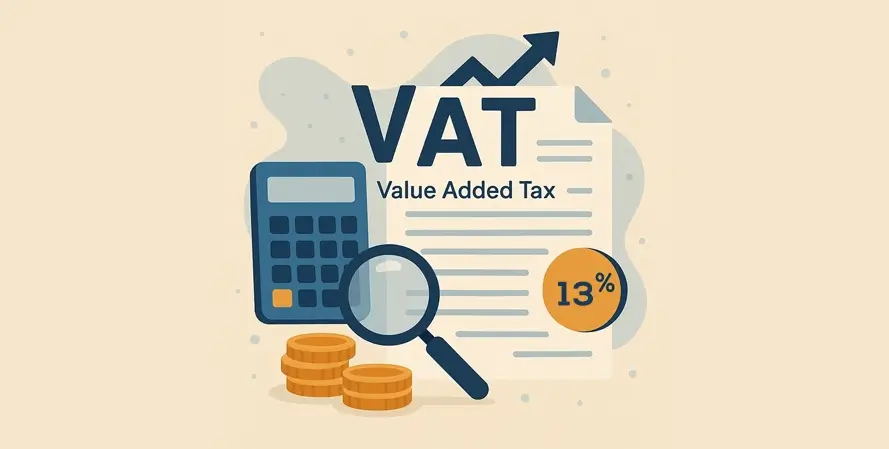Value Added Tax (VAT) is an important tax in Nepal. Any business that earns above a certain limit must register for VAT. Registering VAT ensures your business follows the law and operates legally.
This guide explains how to register VAT online in Nepal, including eligibility, documents, fees, and common mistakes. Whether you are a small business owner or running a growing company, this article will make VAT registration simple for 2025.

What is VAT?
VAT (Value Added Tax) is an indirect tax added to goods and services. It is collected at every step of production and sales.
- Who regulates VAT? The Inland Revenue Department (IRD) manages VAT in Nepal.
- VAT rate: 13% of the selling price of goods or services.
- How it works:
- Production Stage: Manufacturer pays VAT on materials.
- Distribution Stage: VAT is applied when goods are sold to wholesalers.
- Retail Stage: VAT is added when wholesalers sell to retailers.
- Final Sale: VAT is added when retailers sell to customers.
Who Needs to Register for VAT in Nepal?
Not all businesses need VAT registration. You must register if your business meets these conditions:
| Business Type | Turnover Threshold |
|---|---|
| Services | More than NPR 20 Lakh per year |
| Goods | More than NPR 50 Lakh per year |
| Mixed | More than NPR 20 Lakh per year |
Note: Some businesses must register for VAT even if they earn less than the threshold. Check the IRD mandatory VAT list for details.
Required Documents for VAT Registration
Before registering online, prepare these documents:
| S.N | Document Name | Notes |
|---|---|---|
| 1 | PAN (Permanent Account Number) | PAN certificate of owner or company |
| 2 | Business Registration Certificate | From Office of Company Registrar or relevant authority |
| 3 | Proof of Business Address | Lease agreement, property ownership certificate, or utility bill |
| 4 | Bank Account Details | Active account in business name |
| 5 | Photo ID of Owner / Directors | Citizenship certificate or passport |
| 6 | Business Type & Activity Details | List of goods/services your business provides |
| 7 | Board Resolution / Partnership Agreement | For companies/partnerships, authorizing VAT registration |
Tip: Make sure scanned copies are clear and follow IRD guidelines.
Step-by-Step Process to Register VAT Online in Nepal
You can register VAT through the IRD e-Services portal. Follow these steps:
Step 1: Create an Account on the IRD e-Services Portal
- Visit the official IRD website: https://ird.gov.np
- Click Sign Up
- Enter name, email, and mobile number
- Set a secure password
Step 2: Login and Select VAT Registration
- Log in to your account
- Click VAT Registration under the e-services menu
Step 3: Fill in Business Details
- Enter business name, PAN, type, and address
- Add details of directors or owners
- Ensure all information matches your documents
Step 4: Upload Documents
- Upload all required documents in PDF or JPG format
- Required: PAN, business registration, proof of address, bank details, ID proof
Step 5: Submit Application
- Review all details carefully
- Click Submit
- Receive an acknowledgement receipt with a reference number
- IRD verifies documents and sends VAT certificate via email or portal
After VAT Registration – What to Do Next
- Display Your VAT Certificate at your business premises.
- File VAT Returns on Time through the IRD portal (monthly or quarterly).
- Issue VAT-compliant Invoices showing VAT separately.
- Update Business Information if your address, ownership, or partners change.
- Renew or Cancel VAT if your business closes or falls below threshold.
Tip: Stay proactive to avoid penalties and ensure smooth operations.
Common Mistakes to Avoid
| Mistake | Explanation | How to Avoid |
|---|---|---|
| Incomplete Documents | Missing PAN, certificate, or ID | Prepare and check documents beforehand |
| Wrong Business Details | Errors in name, PAN, or address | Double-check before submitting |
| Late Registration | Registering after crossing threshold | Track turnover and register on time |
| Not Filing Returns | Leads to fines | File returns on time |
| Non-Compliant Invoices | Missing VAT details | Issue proper VAT invoices |
| Not Updating Changes | Address or ownership changes not updated | Update promptly on IRD portal |
How to Calculate VAT in Nepal
- VAT Rate: Standard rate is 13%
- Taxable Value: Total price before VAT
- VAT Amount: Taxable Value × VAT Rate
- Total Price: Taxable Value + VAT Amount
Example:
- Product price: NPR 1,000
- VAT: 1,000 × 13% = NPR 130
- Total Price: 1,000 + 130 = NPR 1,130